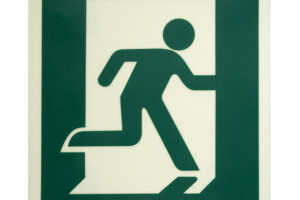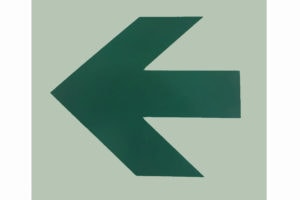Whether you are operating a large manufacturing plant or a small office building, it is important to have a thorough understanding of the laws and codes surrounding means of egress. There are a variety of regulations in place to ensure that the means of egress is clearly indicated with highly visible signage and markings. In this guide, we discuss means of egress signs and markings and ways you can effectively implement the code-required signage.
Means of Egress 101
A means of egress refers to a clear and unobstructed path that allows individuals to leave a building, structure, or other enclosed areas. A means of egress consists of three components: exit access, exit, and exit discharge.
- Exit Access. The route from anywhere in the building to an exit.
- Exits. The doors that lead to exit stairways, horizontal exits, and outside.
- Exit Discharge. The route from the exit to a public road, sidewalk, or alley.
Means of Egress Requirements
The International Building Code (IBC) sets the standard for means of egress for most United States jurisdictions. IBC regulations indicate that at least two means of egress must be available from all buildings and spaces, with certain exceptions. According to the IBC, the means of egress must also be accessible. An accessible means of egress is an exit path free of obstructions that provides a clear route to an exit or area of refuge. Accessible means of egress can share paths from more than one location to an exit, but the IBC does establish maximum distances from accessible spaces to exits.
Marking of Means of Egress
To ensure that individuals are directed along safe paths of egress, the IBC, American Disabilities Act (ADA), and National Fire Protection Agency (NFPA) have established signage and marking guidelines and regulations. Safe-T-Nose is pleased to offer a variety of marking systems, directional and exit signs, and other solutions that meet and exceed these requirements.
Photoluminescent Egress Path Marking Systems
While photoluminescent egress path marking systems are not always required by means of egress codes, they can enhance the safety of egress pathways by adding visual contrast. They are particularly useful for poorly lit areas where natural light cannot reach during a power outage. Safe-T-Nose photoluminescent strips and tapes can be applied to the following areas to ensure safe egress:
- Steps. Meet egress stair requirements by marking the edges of steps with Step Edge Marking and Nosings or Rhino Tred® to keep people from losing their footing on unlit or poorly lit stairways.
- Landings. Illuminate the edges of landings with Photoluminescent Tapes and Strips, for safer egress pathways.
- Handrails. Highlight handrails with Handrail Marking tape to ensure that individuals can stabilize themselves on darkened stairways, ramps, and landings.
- Obstacles. Clearly mark any obstacles in or near the means of egress to prevent trip and fall hazards.
- Door Frames and Hardware. Use photoluminescent tape and strips around door frames and on hardware to help people locate and operate exit doors.
Directional and Exit Signs
The NFPA establishes specific guidelines with regard to exit signs, including sign size, height requirements, and location in relation to the exit door. NFPA exit sign requirements indicate that signs must be at least 4″ high and centered horizontally on the door at a maximum height of 18″ from the floor.
Directional signs can be used to provide clear direction using arrows, running man symbols, and maps to meet residential and commercial building egress requirements. Safe-T-Nose offers Directional and Exit Signs to comply with the size, lighting, and location requirements indicated by the NFPA, IBC, OSHA, and other regulatory bodies.
Compliance With the IBC, NFPA, OSHA, and ADA
In addition to state and local regulatory requirements, your egress marking and exit sign requirements must meet OSHA, NFPA, IBC, and ADA requirements. Below are some of the most important rules and regulations to consider when posting signage and marking your building’s means of egress.
At Safe-T-Nose, we consider the safety of our clients to be our highest priority. That’s why we work to ensure that our signage and marking products meet and exceed industry and regulatory standards for means of egress. Visit our Applicable Codes page to learn more about different signage and marking requirements.
Contact The Experts at Safe-T-Nose for Quality Means of Egress Marking Solutions
Safe-T-Nose is a leading provider of egress marking and signage for both new construction and existing facilities. Our signage solutions are designed to meet and exceed all applicable codes and regulatory requirements, including IBC, NFPA, ICC, UL 1994, and ASTM standards. Our photoluminescent signs undergo frequent testing to ensure optimal quality and are designed to remain visible in the event of a fire or power outage. All of our products are also non-hazardous and non-electrical and provide reliable and long-lasting performance.
To learn more about our signage and marking solutions, contact us today!









